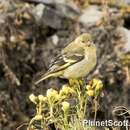Spinus – rodzaj ptaka z rodziny łuszczakowatych (Fringillidae).
Występowanie
Rodzaj obejmuje gatunki występujące w Eurazji i w Ameryce[6].
Morfologia
Długość ciała 9-13 cm, masa ciała 6-20 g[7].
Systematyka
Etymologia
Nazwa rodzajowa pochodzi od epitetu gatunkowego Fringilla spinus Linnaeus, 1758 (greckie σπινος spinos – niezidentyfikowany ptak wspomniany przez Arystofanesa, Dionizego, Hezychiusza i innych, zwykle traktowany jako typ „zięby” (σπιζω spizō – „ćwierkać”))[8].
Fringilla spinus Linnaeus
Podział systematyczny
Takson wyodrębniony niedawno z Carduelis[9][10][11][12][13][14][15][16][17]. Do rodzaju należą następujące gatunki[6][18]:
Uwagi
-
↑ Greckie σπορα spora – „nasienie, ziarno” (σπειρω speirō – „siać”); αγρα agra – „polowanie” (αγρεω agreō – „polować”).
-
↑ Greckie αστραγαλινος astragalinos – mały ptak wspomniany przez Dioniziusa, prawdopodobnie jakiś gatunek zięby.
-
↑ Greckie χιων khiōn, χιονος khionos – „śnieg”; rodzaj Chrysomitris Boie, 1828.
Przypisy
-
↑ Spinus, w: Integrated Taxonomic Information System (ang.).
-
↑ C.L. Koch: System der baierischen Zoologie. Cz. 1: Die Säuughtiere und Vogel baierns. Monachium: Nürnberg, 1816, s. 232. (niem.)
-
↑ H.G.L. Reichenbach: Avium systema naturale. Das natürliche system der vögel mit hundert tafeln grösstentheils original-abbildungen der bis jetzt entdecken fast zwölfhundert typischen formen. Vorlaüfer einer iconographie der arten der vögel aller welttheile. Drezno i Lipsk: Expedition der vollständigsten naturgeschichte, 1850, s. tab. lxxix. (niem.)
-
↑ J. Cabanis: Museum Heineanum: Verzeichniss der ornithologischen Sammlung des Oberamtmann Ferdinand Heine, auf Gut St. Burchard vor Halberstadt. Cz. 1. Halberstatd: In Commission bei R. Frantz, 1851, s. 159. (niem.)
-
↑ H. Wolters: Die Vogelarten der Erde. Eine systematische Liste mit Verbreitungsangaben sowie deutschen und englischen Namen. Hamburg i Berlin: Verlag Paul Parey, s. 302. (niem.)
-
↑ a b F. Gill, D. Donsker: Finches, euphonias (ang.). IOC World Bird List: Version 5.4. [dostęp 2015-12-10].
-
↑ N. Collar, I. Newton, P. Clement, V. Arkhipov: Family Fringillidae (Finches). W: Josep del Hoyo, Andrew Elliott, David A. Christie: Handbook of the Birds of the World. Cz. 15: Weavers to New World Warblers. Barcelona: Lynx Edicions, 2010, s. 546-560. ISBN 978-84-96553-68-2. (ang.)
-
↑ J.A. Jobling: Key to Scientific Names in Ornithology. W: J. del Hoyo, A. Elliott, J. Sargatal, D.A. Christie, E. de Juana (red.): Handbook of the Birds of the World Alive. Barcelona: Lynx Edicions, 2015. [dostęp 2015-12-10]. (ang.)
-
↑ A. Arnaiz-Villena, M. Álvarez-Tejado, V. Ruíz-del-Valle, C. García-de-la-Torre, P. Varela, M.J. Recio, S. Ferre, J. Martínez-Laso. Phylogeny and rapid Northern and Southern Hemisphere speciation of goldfinches during the Miocene and Pliocene Epochs. „Cellular and Molecular Life Sciences”. 54, s. 1031-1041, 1998 (ang.).
-
↑ A. Arnaiz-Villena, J. Guilléna, V. Ruiz-del-Vallea, E. Lowy, J. Zamoraa, P.Varelaa, D. Stefanib, L.M. Allendea. Phylogeography of crossbills, bullfinches, grosbeaks, and rosefinches. „Cellular and Molecular Life Sciences”. 58 (8), s. 1159-1166, 2001 (ang.).
-
↑ A. Arnaiz-Villena, E. Lowy, V. Ruiz-del-Valle, H. Westerdahl, Ju. Moscoso, J.I. Serrano-Vela, H. Witzell, J. Zamora. Evolution of the major histocompatibility complex class I genes in Serinus canaria from the Canary Islands is different from that of Asian and African continental Serinus species. „Journal of Ornithology”. 148 (Suppl. 2), s. S479–S484, 2007. DOI: 10.1007/s10336-007-0146-0 (ang.).
-
↑ A. Arnaiz-Villena, J. Moscoso, V. Ruiz-Del-valle, J. Gonzalez, R. Reguera, M. Wink, J.I. Serrano-Vela. Bayesian phylogeny of Fringillinae birds: status of the singular African oriole finch Linurgus olivaceus and evolution and heterogeneity of the genus Carpodacus. „Acta Zoologica Siniaca”. 53 (5), s. 826-834, 2007 (ang.).
-
↑ A. Arnaiz-Villena, J. Moscoso, V. Ruiz-del-Valle, J. Gonzalez, R. Reguera, A. Ferri, M. Wink, J.I. Serrano-Vela. Mitochondrial DNA Phylogenetic Definition of a Group of ‘Arid-Zone’ Carduelini Finches. „The Open Ornithology Journal”. 1, s. 1-7, 2008 (ang.).
-
↑ J. Zamora, E. Lowy, V. Ruiz-del-Valle, J. Moscoso, J.I. Serrano-Vela, J. Rivero-de-Aguilar, A. Arnaiz-Villena. Rhodopechys obsoleta (desert finch): a pale ancestor of greenfinches (Carduelis spp.) according to molecular phylogeny. „Journal of Ornithology”. 147, s. 448-456, 2006. DOI: 10.1007/s10336-005-0036-2 (ang.).
-
↑ J. Zamora, J. Moscoso, V. Ruiz-del-Valle, E. Lowy, J.I. Serrano-Vela, J. Ira-Cachafeiro, A. Arnaiz-Villena. Conjoint mitochondrial phylogenetic trees for canaries Serinus spp. and goldfinches Carduelis spp. show several specific polytomies. „Ardeola”. 53 (1), s. 1-17, 2006 (ang.).
-
↑ B. Nguembock, J. Fjeldså, A. Couloux, E. Pasquet. Molecular phylogeny of Carduelinae (Aves, Passeriformes, Fringillidae) proves polyphyletic origin of the genera Serinus and Carduelis and suggests redefined generic limits. „Molecular Phylogenetics and Evolution”. 51 (2), s. 169-181, 2009. DOI: 10.1016/j.ympev.2008.10.022 (ang.).
-
↑ D. Zuccon, R. Prŷs-Jones, P.C. Rasmussen, P.G.P. Ericson. The phylogenetic relationships and generic limits of finches (Fringillidae). „Molecular Phylogenetics and Evolution”. 62 (2), s. 581-596, 2012. DOI: 10.1016/j.ympev.2011.10.002 (ang.).
-
↑ Systematyka i nazwy polskie za: P. Mielczarek, M. Kuziemko: Plemię: Carduelini Vigors, 1825 (wersja: 2015-07-08). W: Kompletna lista ptaków świata [on-line]. Instytut Nauk o Środowisku Uniwersytetu Jagiellońskiego. [dostęp 2015-12-10].

